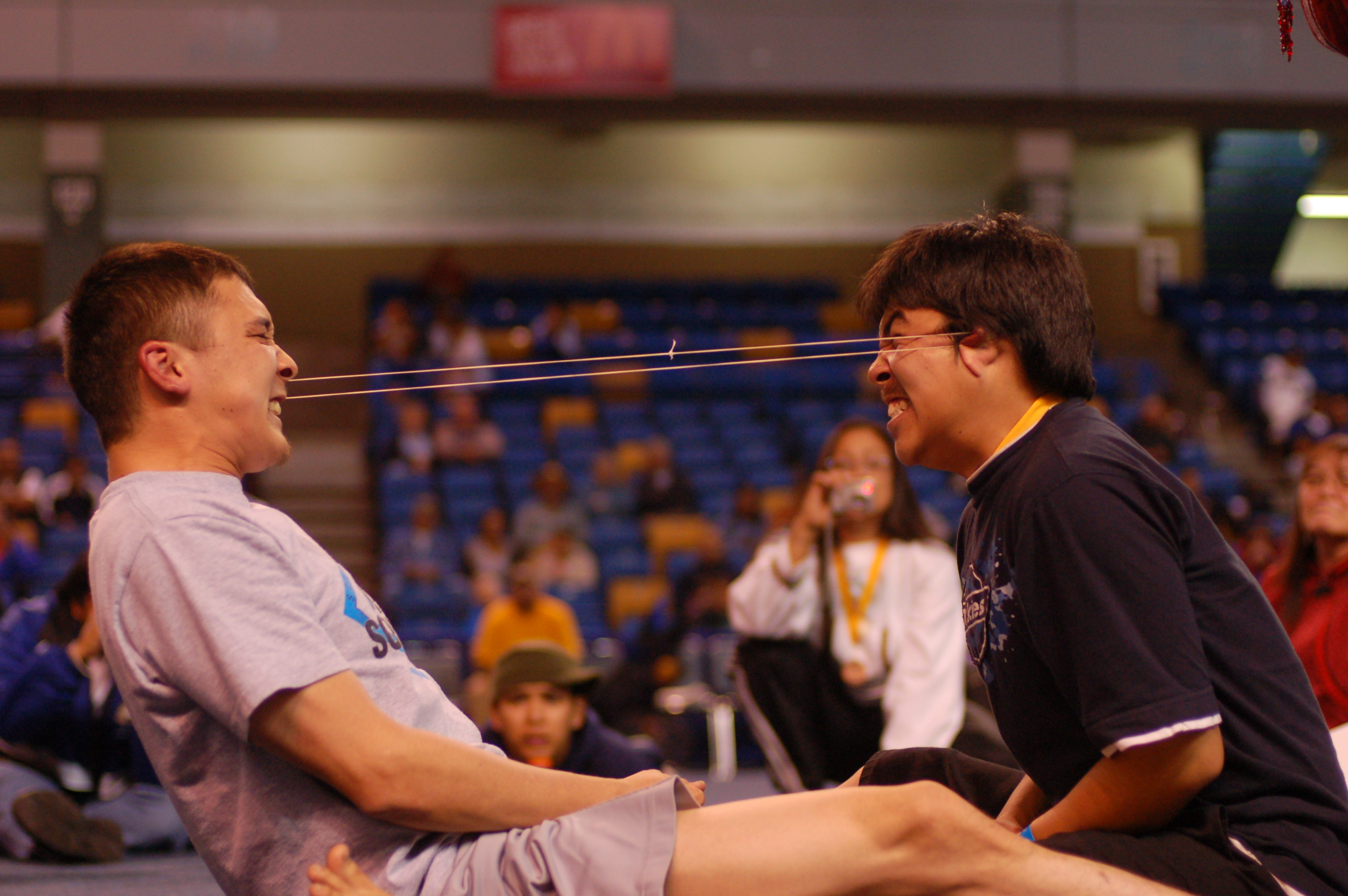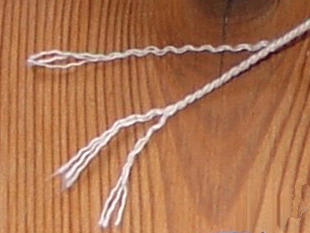|
Ear Pull
The ear pull is a traditional Inuit game or sport which tests the competitors' ability to endure pain, and also strength. In the ear pull, two competitors sit facing each other, their legs straddled and interlocked. A two-foot-long loop of string, similar to a thick, waxed dental floss, is looped behind their ears In vertebrates, an ear is the organ that enables hearing and (in mammals) body balance using the vestibular system. In humans, the ear is described as having three parts: the outer ear, the middle ear and the inner ear. The outer ear co ..., connecting right ear to right ear, or left ear to left ear. The competitors then pull upon the opposing ear using their own ear until the cord comes free or the opponent quits from the pain. The game has been omitted from some Arctic sports competitions due to safety concerns and the squeamishness of spectators; the event can cause bleeding and competitors sometimes require stitches. The ear pull is one example of Inu ... [...More Info...] [...Related Items...] OR: [Wikipedia] [Google] [Baidu] |
Inuit
Inuit (singular: Inuk) are a group of culturally and historically similar Indigenous peoples traditionally inhabiting the Arctic and Subarctic regions of North America and Russia, including Greenland, Labrador, Quebec, Nunavut, the Northwest Territories, Yukon (traditionally), Alaska, and the Chukotsky District of Chukotka Autonomous Okrug. The Inuit languages are part of the Eskaleut languages, also known as Inuit-Yupik-Unangan, and also as Eskimo–Aleut. Canadian Inuit live throughout most of Northern Canada in the territory of Nunavut, Nunavik in the northern third of Quebec, the Nunatsiavut in Labrador, and in various parts of the Northwest Territories and Yukon (traditionally), particularly around the Arctic Ocean, in the Inuvialuit Settlement Region. These areas are known, by Inuit Tapiriit Kanatami and the Government of Canada, as Inuit Nunangat. In Canada, sections 25 and 35 of the Constitution Act of 1982 classify Inuit as a distinctive group of Abo ... [...More Info...] [...Related Items...] OR: [Wikipedia] [Google] [Baidu] |
Sport
Sport is a physical activity or game, often Competition, competitive and organization, organized, that maintains or improves physical ability and skills. Sport may provide enjoyment to participants and entertainment to spectators. The number of participants in a particular sport can vary from hundreds of people to a single individual. Sport competitions may use a team or single person format, and may be Open (sport), open, allowing a broad range of participants, or closed, restricting participation to specific groups or those invited. Competitions may allow a "tie" or "draw", in which there is no single winner; others provide tie-breaking methods to ensure there is only one winner. They also may be arranged in a tournament format, producing a champion. Many sports leagues make an annual champion by arranging games in a regular sports season, followed in some cases by playoffs. Sport is generally recognised as system of activities based in physical athleticism or physical de ... [...More Info...] [...Related Items...] OR: [Wikipedia] [Google] [Baidu] |
Pain Tolerance
Pain tolerance is the maximum level of pain that a person is able to tolerate. Pain tolerance is distinct from pain threshold (the point at which pain begins to be felt)."IASP Taxonomy, Pain Terms". Retrieved 4 December 2014 The of pain that goes in to pain tolerance has two major components. First is the biological component—the headache or skin prickling that activates pain receptors. Second is the brain’s perception of pain—how much focus is spent paying attention to or ignoring the pain. The brain’s perception of pain is a response to signals from pain receptors that sensed the pain in the first place. Factors Sex < ...
|
Twine
Twine is a strong Thread (yarn), thread, light String (structure), string or cord composed of string in which two or more thinner strands are twisted, and then twisted together (Plying, plied). The strands are plied in the opposite direction to that of their twist, which adds torsional strength to the cord and keeps it from unravelling. This process is sometimes called reverse wrap. The same technique used for making twine is also used to make Thread (yarn), thread, which is thinner, yarn, and rope, which is stronger and thicker, generally with three or more strands. Natural fibres used for making twine include wool, cotton, sisal, jute, hemp, henequen, paper, and coir. A variety of synthetic fibres are also used. Twine is a popular substance used in modern-day crafting. Prehistoric The invention of twine is at least as important as the development of Stone tool, stone tools for early humans. Indeed, Elizabeth Wayland Barber has called the development of twine, which can be ... [...More Info...] [...Related Items...] OR: [Wikipedia] [Google] [Baidu] |
Pinna (anatomy)
The auricle or auricula is the visible part of the ear that is outside the head. It is also called the pinna (Latin for 'wing' or ' fin', : pinnae), a term that is used more in zoology. Structure The diagram shows the shape and location of most of these components: * '' antihelix'' forms a 'Y' shape where the upper parts are: ** ''Superior crus'' (to the left of the ''fossa triangularis'' in the diagram) ** ''Inferior crus'' (to the right of the ''fossa triangularis'' in the diagram) * ''Antitragus'' is below the ''tragus'' * ''Aperture'' is the entrance to the ear canal * ''Auricular sulcus'' is the depression behind the ear next to the head * ''Concha'' is the hollow next to the ear canal * Conchal angle is the angle that the back of the ''concha'' makes with the side of the head * ''Crus'' of the helix is just above the ''tragus'' * ''Cymba conchae'' is the narrowest end of the ''concha'' * External auditory meatus is the ear canal * ''Fossa triangularis'' is the depression ... [...More Info...] [...Related Items...] OR: [Wikipedia] [Google] [Baidu] |
Serena Nanda
Serena Nanda (born August 13, 1938) is an American author, anthropologist, and professor emeritus. She received the Ruth Benedict Prize in 1990 for her monograph, ''Neither Man nor Woman: The Hijras of India''. Biography Serena Nanda was born on August 13, 1938, in New York City and received her Doctor of Philosophy in anthropology from New York University. She is the co-author of two anthropology textbooks: ''Culture Counts: A Concise Introduction to Cultural Anthropology (5th Edition)'' and ''Cultural Anthropology (12th edition)''. Among her areas of specialty was the topic of gender diversity, having written the major reference book on the hijras of India. As of August 2021, she was a professor emeritus at the John Jay College of Criminal Justice The John Jay College of Criminal Justice (John Jay) is a public college focused on criminal justice and located in New York City. It is a senior college of the City University of New York (CUNY). John Jay was founded as the only ... [...More Info...] [...Related Items...] OR: [Wikipedia] [Google] [Baidu] |
World Eskimo Indian Olympics
The World Eskimo-Indian Olympics (or WEIO) is an annual USA national multi-sport event held over a four-day period beginning the 3rd Wednesday each July, designed to preserve cultural practices and traditional (survival) skills essential to life in circumpolar areas of the world. These games are only between Native Americans in the United States and allow no participants from other nations. Sport and Culture Events The WEIO features games or sports rooted in ancestral hunting and survival techniques employed by the Inuit, Iñupiat, Yupik, and other Native Americans in USA, as well as dance, storytelling competitions, and an annual cultural pageant, called Miss WEIO, that focuses on cultural knowledge. History WEIO began in 1961 as the World Eskimo Olympics and was initially held on the banks of the Chena River in downtown Fairbanks, Alaska, in conjunction with the Golden Days celebration festivities. The event was sponsored by the City of Fairbanks, through the city's Chamber ... [...More Info...] [...Related Items...] OR: [Wikipedia] [Google] [Baidu] |
Endurance Games
Endurance (also related to sufferance, forbearance, resilience, constitution, fortitude, persistence, tenacity, steadfastness, perseverance, stamina, and hardiness) is the ability of an organism to exert itself and remain active for a long period of time, as well as its ability to resist, withstand, recover from and have immunity to trauma, wounds, or fatigue. The term is often used in the context of aerobic or anaerobic exercise. The definition of "long" varies according to the type of exertion – minutes for high intensity anaerobic exercise, hours or days for low intensity aerobic exercise. Training for endurance can reduce endurance strength unless an individual also undertakes resistance training to counteract this effect. When a person is able to accomplish or withstand more effort than previously, their endurance is increasing. To improve their endurance they may slowly increase the amount of repetitions or time spent; in some exercises, more repetitions tak ... [...More Info...] [...Related Items...] OR: [Wikipedia] [Google] [Baidu] |
Games Of Physical Skill
A game of skill is a game where the outcome is determined mainly by mental or physical skill, rather than chance. Alternatively, a game of chance is one where its outcome is strongly influenced by some randomizing device, such as dice, spinning tops, playing cards, roulette wheels, or numbered balls drawn from a container. While a game of chance may have some skill element to it, chance generally plays a greater role in determining its outcome. A game of skill may also have elements of chance, but skill plays a greater role in determining its outcome. Some commonly played games of skill and chance include: poker, collectible card games, contract bridge, backgammon and mahjong. Most games of skill also involve a degree of chance, due to natural aspects of the environment, a randomizing device (such as dice, playing cards or a coin flip), or guessing due to incomplete information. For many games where skill is a component alongside chance, such as card games like poker but ... [...More Info...] [...Related Items...] OR: [Wikipedia] [Google] [Baidu] |
Individual Sports
An individual is one that exists as a distinct entity. Individuality (or self-hood) is the state or quality of living as an individual; particularly (in the case of humans) as a person unique from other people and possessing one's own needs or goals, rights and responsibilities. The concept of an individual features in many fields, including biology, law, and philosophy. Every individual contributes significantly to the growth of a civilization. Society is a multifaceted concept that is shaped and influenced by a wide range of different things, including human behaviors, attitudes, and ideas. The culture, morals, and beliefs of others as well as the general direction and trajectory of the society can all be influenced and shaped by an individual's activities. Etymology From the 15th century and earlier (and also today within the fields of statistics and metaphysics) ''individual'' meant " indivisible", typically describing any numerically singular thing, but sometimes mea ... [...More Info...] [...Related Items...] OR: [Wikipedia] [Google] [Baidu] |






